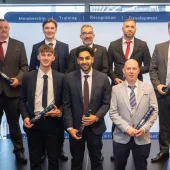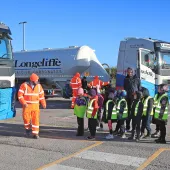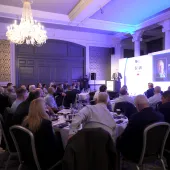Institute of Quarrying and HSE host Safety Conference

First published in the March 2015 issue of Quarry Management as How Safe are You?
Institute of Quarrying’s Derbyshire branch and the HSE host third annual Safety Conference
The Derbyshire branch of the Institute of Quarrying (IQ) held its third annual Safety Conference on 8 October 2014, in conjunction with the Health and Safety Executive (HSE). The event took place at the Proact Stadium, in Chesterfield, where a variety of presentations were delivered by several specialists within the industry.
The day opened with an introduction from Richard Noble of the HSE and Kim Shilcock, chair of the Derbyshire branch. Roy Bush (HSE) was also on hand to provide an insight into hard targets, with particular focus on Regulation 40 – workforce engagement/involvement, detailing the operator’s duty to co-operate effectively in promoting and developing measures in the workplace along with checking their effectiveness.
Roy followed on by focusing on accident rates, drawing attention to reports of minor accidents plateauing over the previous five years, with major accidents and fatalities slightly increasing. To counter this he suggested linking incentives to health and safety performance, while also raising the question as to whether all minor accidents are being reported. Contractor accident reporting was also covered before attention was brought to the role that QNJAC undertakes through communication, incident investigation, inductions and education.
Jon Butterworth of National Grid followed with a presentation entitled ‘How safe are you? Creating a generative culture based on Piper Alpha’. The talk started with an overview of the national grid and safety performance, before an example of a fatality was shown – something that could have been avoided with the correct use of procedures. He suggested that an accident is not a failure of a single mechanism but a failure of multiple layers of protection, stating that an accident can happen when ‘all the holes line up’. This was demonstrated by analysis of the Piper Alpha disaster, which was shown to have been a result of not just one, but multiple failed ‘layers of protection’.
Colin Jenkins, President of the IQ (2012–14) covered ‘Why workforce engagement matters at your quarry & how to do it’. He stated that it is people who make the difference through workforce engagement. The report ‘Engaging for success’ (Macleod 2009) suggested organizations that inspire and engage employees produce world-class levels of innovation, productivity and performance. Evidence from the HSE also suggests that improving leadership and workforce engagement directly improves occupational health and safety. There are means of achieving genuine workforce engagement and real change can be made through driving improvements site-wide, providing strong leadership accompanied with a genuine desire to create a positive site culture and true employee engagement.
Bob Robinson of Hope Construction Materials gave an insight into the challenges and processes involved in uniting two health and safety cultures, where the aim was to create a safety culture capable of fitting and embracing all, to make people feel comfortable and confident in the new business. One of the main driving forces was the creation of an identity; the success of this team, ‘Hope United’, depended on visible felt leadership, requiring managers to become leaders in helping employees to feel more valued and motivated. In asking why health and safety really matters, he used a child’s words ‘I want you to keep my daddy safe, because I love him…a lot!’
Craig Arditto and Ian Brown of Lafarge Tarmac contributed a joint presentation on the link between geology and quarry face operations, making the point that quarry safety is not just about understanding geology. Examples were shown of replacement plant brought in to suit the geology, linking geological and geotechnical process with human behaviour through safe working. Geology–assessment–management–documents–operations (all chain linked) must be considered for safe working. They explored the tools available including geotechnical assessments, review meetings, optimization and training, among others.
After lunch, Richard Noble celebrated 40 years of the Health and Safety at Work Act 1974, before talking about accidents and incidents in the industry. He reminded the audience of past major events relating to failures in health and safety while iterating that it is our duty to prevent events like these from reoccurring. Richard outlined a review, ‘Health and safety made simple’, that removes 20 unnecessary regulations (up to November 2013), before speaking about RIDDOR (Reporting of Injuries, Diseases and Dangerous Occurrences Regulations) requirements, which was accompanied by a series of videos showing the long-term effects of exposure to substances hazardous to health, such as silica dust, with a focus on the effects on individuals and available prevention measures. A fee for intervention review revealed income of £12.3million, with 24,260 invoices averaging £508.
The final presentation, given by Rob Shore, focused on the behaviours of an effective incident investigation team. He suggested that the road to success in health and safety comprises four steps; Plan–Do–Check–Act, making references to RIDDOR. Rob suggested the profile of a competent investigation team, with the scale of an investigation being dependent on the actual outcome of the incident, along with its potential severity, in order to prevent reoccurrence. The presentation finished with a final point that before pointing a finger, always consider there will be three fingers pointing back at you.
The conference ended with thanks to the event organizers and venue staff, and to the speakers who delivered important messages and provided fresh insight into health and safety within the industry following on from the successes made in previous years.
- Subscribe to Quarry Management, the monthly journal for the mineral products industry, to read articles before they appear on Agg-Net








